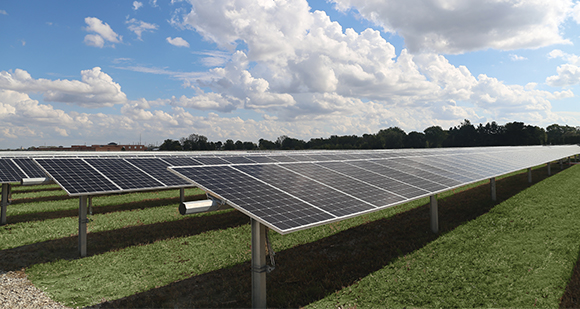Among the memorable scenes from the new documentary about the late Anthony Bourdain, the celebrity journo-chef, is one that takes place on a psychiatrist’s couch. Bourdain, by most outward measures resoundingly successful, is asked a simple, yet fundamental question: “Do you really want to change?”
There can be little doubt that change — as opposed to habitually grinding away at what seems to work for now — can be challenging, laborious, even scary. It is, however, a foundational precept of the Indiana Municipal Power Agency (IMPA), a wholesale power provider to 61 not-for-profit, municipal utilities across Indiana and in Ohio.
“Constant change,” says CEO Raj Rao, “is the reason for our success across more than three decades. If you stick to one plan,” Rao tells Site Selection, “you’re going to be antiquated pretty quickly.”
Rao should know. He’s been at IMPA’s helm since shortly after its founding in 1983. He authored IMPA’s original logo, sketching it on a restaurant napkin. Rao has seen the Carmel, Indiana–based agency increase its initial membership fivefold, while expanding its holdings and portfolio.
Even Rao’s long-time logo isn’t sacred. This year, IMPA unveiled a new one, one that reflects a new era in the energy industry with the precipitous rise of alternatives. With a nod to the lightning bolt in Rao’s original rendering, the new IMPA logo thus sports colorful ribbons of yellow, orange, blue and green.
“The diversity of colors,” he says, “reflects the increasing diversity of IMPA’s power supply portfolio, which includes solar, wind, nuclear, natural gas and coal resources. We are changing and moving in the right direction, and that’s what the new logo conveys.”
Taking the Lead
Change, however, revolves around a bedrock mandate, says Rao. IMPA believes in low rates and reliable power that is environmentally responsible. The latter consideration is becoming increasingly crucial, Rao says, as the user public demands more renewable options, and as power providers worldwide race toward a post-carbon future.
IMPA has managed to forge a head start, having already built some 35 small-scale solar parks, more than any other utility in the country, Rao says. “Compared to others,” he says, “we’re in a very good place.”
How that happened is a telling reflection of IMPA’s drive for innovation, which the plucky utility couples with a solid ground game.
… If we don’t know how, we’ll learn.”
— Raj Rao, IMPA CEO
“We started thinking about solar in 2010,” says Rao, a time at which an Indianapolis utility had begun to generate solar power at a cost of about 25 cents per kilowatt hour. “I looked at that and said, ‘That’s ridiculous,’ ” Rao recalls. “I told my board I could do it for 10 cents.
“We did it pretty much all in house,” Rao recalls of IMPA’s first venture into solar. “We believe we can do it better than others, so if we don’t know how, we’ll learn. We did the engineering ourselves with the help of a few consultants, and we ended up doing it for less than seven cents per kilowatt hour,” he says.
The utility currently owns about 75% of the solar electricity it supplies to its members; the rest IMPA purchases wholesale as it continues to expand its solar portfolio. To realize its goal of a solar park for each of its 61 member municipalities, the utility teams with local officials to build solar installations within city boundaries, a win for both users and the cities’ tax coffers.
IMPA’s forward-leaning posture toward solar is welcomed even in places like rural Greene County, which is Indiana coal country. There, IMPA has broken ground on a 10-MW solar park on 40 acres within the town of Linton, an IMPA member municipality. The solar park, says Mayor John Wilkes, should enter operation in early 2022.
“We have a big stake in the coal industry,” Wilkes says, “but people here know we have got to come up with alternative sources of power. We’re happy to get solar and to be part of something that’s going to be a thing of future.”
A Partner for Progress
For towns like Linton, says Wilkes, IMPA membership allows for “local ownership, local control and local service. And that’s important.” When the power goes out, he notes, the crews that restore it live locally and react swiftly.
But IMPA, he says, “does a whole lot of things for us,” primarily in the realm of economic development.
“We are basically a resource to our member communities,” says Bryan Brackemyre, IMPA’s vice president of member services. “And it’s not a one-size-fits-all approach, because different size communities have different economic development needs.”
In the case of Linton, IMPA pitched in to help fund one of the city’s priority projects, the 70-acre Linton Industrial Park, home to the recently expanded ProMark, a steel manufacturing company that employs 22 people on three buildings spread out across 10 acres. In addition to running lines to the park and offering preferred rates to industrial customers like ProMark, the utility helped to fund a recent appraisal process by Verisite, the Indianapolis-based site certification consultant.
“Now,” says Wilkes, “I’ve got a Silver Certified industrial park with great utilities leading to it.”
IMPA, he says, is helping to market the park, and has facilitated contacts with Japanese automotive companies the city is actively courting. Wilkes believes that Linton, which forms a triangle with Bloomington and Terre Haute, is an attractive location.
“We’re less than an hour as far as shopping, and we have several universities that are also less than an hour’s drive. I’m optimistic,” he declares, “that we will land some of these projects. It takes time, but now our park is certified, and I’m optimistic that things will happen.”
This Investment Profile was prepared under the auspices of the Indiana Municipal Power Agency. For more information, contact Bryan Brackemyre at 317-575-3879 or by email at bryanb@impa.com. On the web, go to www.impa.com.

